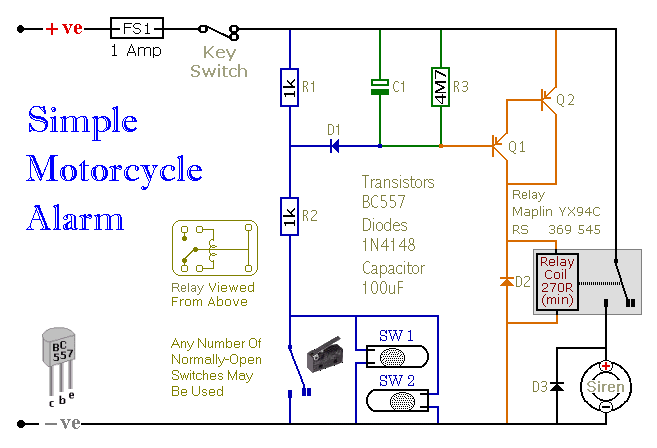
Motorcycle Alarm Number 4

Motorcycle Alarm Number 4. This is a simple, easy-to-build, transistor-based motorcycle alarm. It is designed to operate at 12 volts; however, it can be adapted by changing the relay to a different specification.
This motorcycle alarm circuit utilizes a transistor as the main switching element, providing a reliable method for activating an alert system when unauthorized access is detected. The design typically includes a relay that controls the alarm sound or light indicator, which can be triggered by various sensors or switches, such as a tilt sensor or a door switch.
The circuit operates on a standard 12-volt power supply, commonly found in motorcycles, ensuring compatibility with the vehicle's electrical system. The transistor is configured in a way that allows it to amplify the current from the sensor to energize the relay. When the sensor is activated, the transistor switches on, allowing current to flow through the relay coil, which then closes the relay contacts and activates the alarm.
For enhanced functionality, the alarm can be modified by selecting a relay with different specifications, which may allow for higher voltage operation or additional features such as a longer alarm duration or alternative signaling methods. The circuit can also be protected against false alarms through the use of diodes and capacitors that filter out noise and provide stability to the operation.
Overall, this motorcycle alarm design prioritizes simplicity and effectiveness, making it suitable for hobbyists and individuals looking to add a layer of security to their motorcycle.Motorcycle Alarm Number 4. This is a simple - easy to build - transistor based motorcycle alarm. It`s designed to work at 12-volts. But - if you change the relay for one. 🔗 External reference
This motorcycle alarm circuit utilizes a transistor as the main switching element, providing a reliable method for activating an alert system when unauthorized access is detected. The design typically includes a relay that controls the alarm sound or light indicator, which can be triggered by various sensors or switches, such as a tilt sensor or a door switch.
The circuit operates on a standard 12-volt power supply, commonly found in motorcycles, ensuring compatibility with the vehicle's electrical system. The transistor is configured in a way that allows it to amplify the current from the sensor to energize the relay. When the sensor is activated, the transistor switches on, allowing current to flow through the relay coil, which then closes the relay contacts and activates the alarm.
For enhanced functionality, the alarm can be modified by selecting a relay with different specifications, which may allow for higher voltage operation or additional features such as a longer alarm duration or alternative signaling methods. The circuit can also be protected against false alarms through the use of diodes and capacitors that filter out noise and provide stability to the operation.
Overall, this motorcycle alarm design prioritizes simplicity and effectiveness, making it suitable for hobbyists and individuals looking to add a layer of security to their motorcycle.Motorcycle Alarm Number 4. This is a simple - easy to build - transistor based motorcycle alarm. It`s designed to work at 12-volts. But - if you change the relay for one. 🔗 External reference





